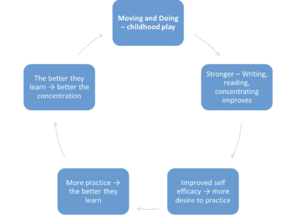The Road to Writing and Moving in Early and Middle Childhood: Difference between revisions
No edit summary |
No edit summary |
||
| Line 20: | Line 20: | ||
* Children who have different brain development, which affects their ability to learn from everyday experiences - i.e. children who do not learn by “doing” | * Children who have different brain development, which affects their ability to learn from everyday experiences - i.e. children who do not learn by “doing” | ||
== Learning Through Play == | |||
[[File:Learning Through Play Diagram.png|thumb|Figure 1. Learning through play.]] | |||
As is shown in Figure 1, children typically experience by “doing” things. The more “doing”, the more learning. The more “doing”, the stronger their muscles get. Strong muscles and exercise are good for writing, reading, concentrating and exercising. Exercise is also good for happiness, health, friendships. | |||
== The Building Blocks of Learning == | |||
== References == | |||
[[Category:Physioplus Content]] | [[Category:Physioplus Content]] | ||
[[Category:Course Pages]] | [[Category:Course Pages]] | ||
[[Category:Paediatrics]] | [[Category:Paediatrics]] | ||
Revision as of 10:51, 4 August 2021
Top Contributors - Jess Bell, Naomi O'Reilly, Kim Jackson, Tarina van der Stockt, Wanda van Niekerk and Cindy John-Chu
Introduction[edit | edit source]
Postural control begins in the brain and ends in the hand or foot. Typically, by the age of 7 years, postural control should be consolidated and automatic and children will be “writing ready” and “sport ready”.[1] However, some children may not develop this postural control for a number of reasons, including:[1]
- They may be too floppy or bendy - i.e. they have low connective tissue tone with underlying weaknesses, even if they are sporty. This may be caused by conditions such as:
- Benign joint hypermobility syndrome
- Marfan syndrome
- Ehlers–Danlos Syndrome (EDS)
- The Beighton Scale is used to measure hypermobility[2]
- Lack of practice, which leads to muscle weakness
- An inability to concentrate on one specific activity
- A child’s temperament
- Too shy
- Too nervous
- Gives up easily
- Children who have different brain development, which affects their ability to learn from everyday experiences - i.e. children who do not learn by “doing”
Learning Through Play[edit | edit source]
As is shown in Figure 1, children typically experience by “doing” things. The more “doing”, the more learning. The more “doing”, the stronger their muscles get. Strong muscles and exercise are good for writing, reading, concentrating and exercising. Exercise is also good for happiness, health, friendships.
The Building Blocks of Learning[edit | edit source]
References[edit | edit source]
- ↑ 1.0 1.1 Prowse T. The Social, Cognitive and Emotional Development of Children - The Road to Writing and Moving Course. Physioplus, 2021.
- ↑ Simmonds J. Generalized joint hypermobility: a timely population study and proposal for Beighton cut-offs. Rheumatology (Oxford). 2017;56(11):1832-3.







